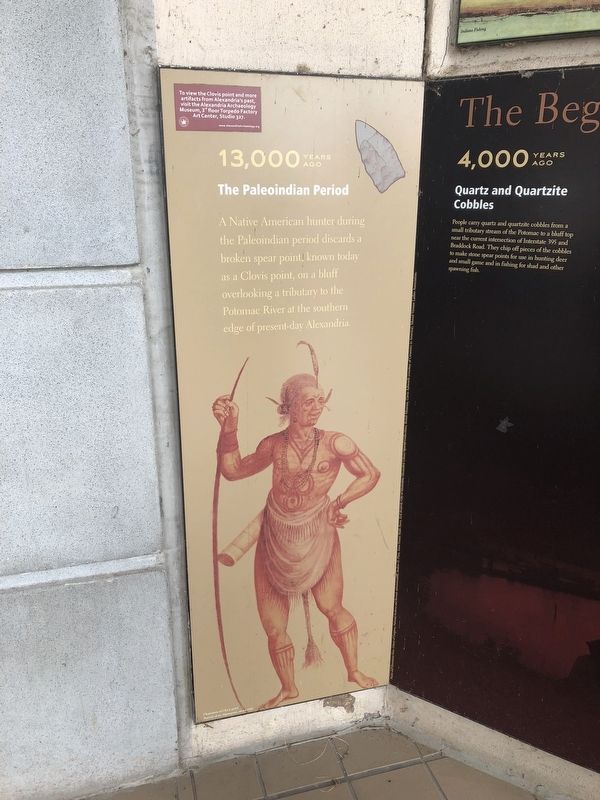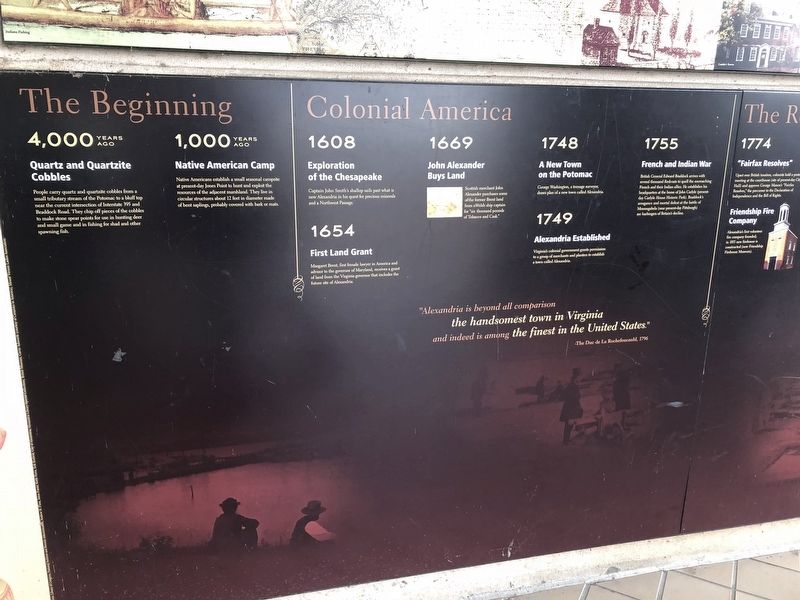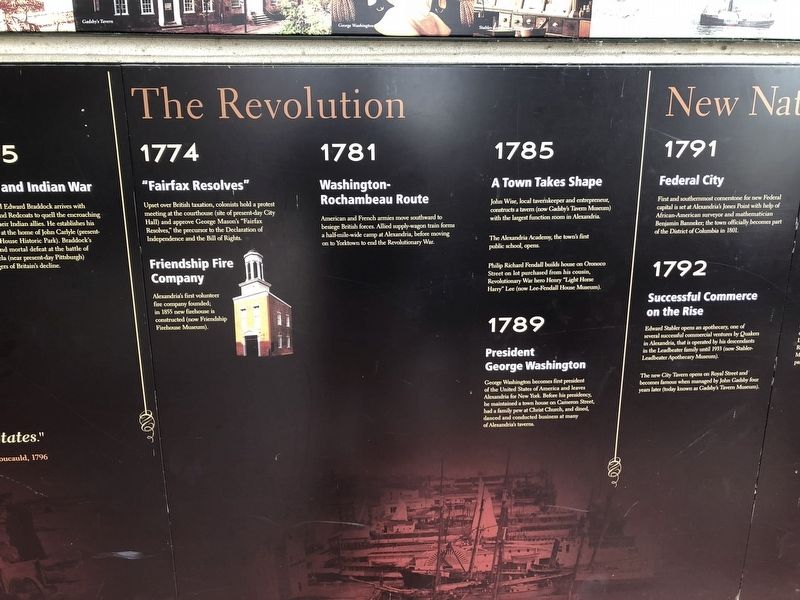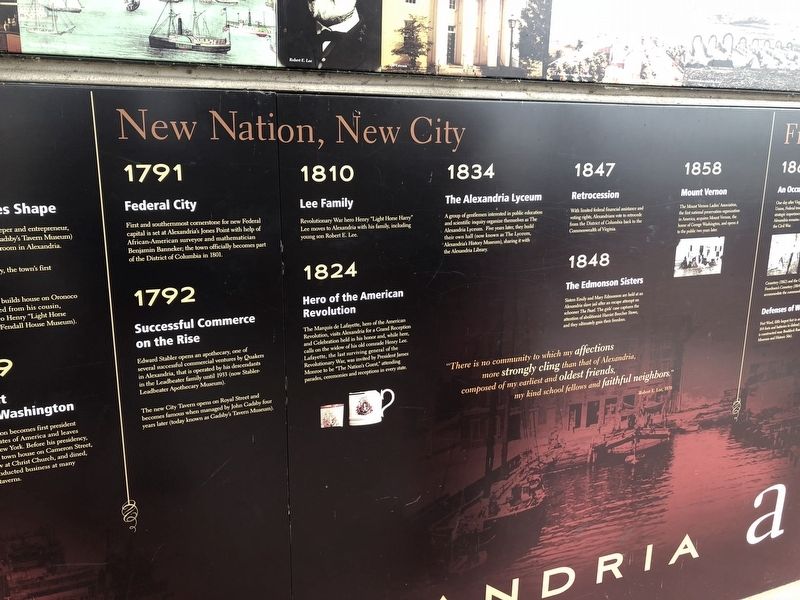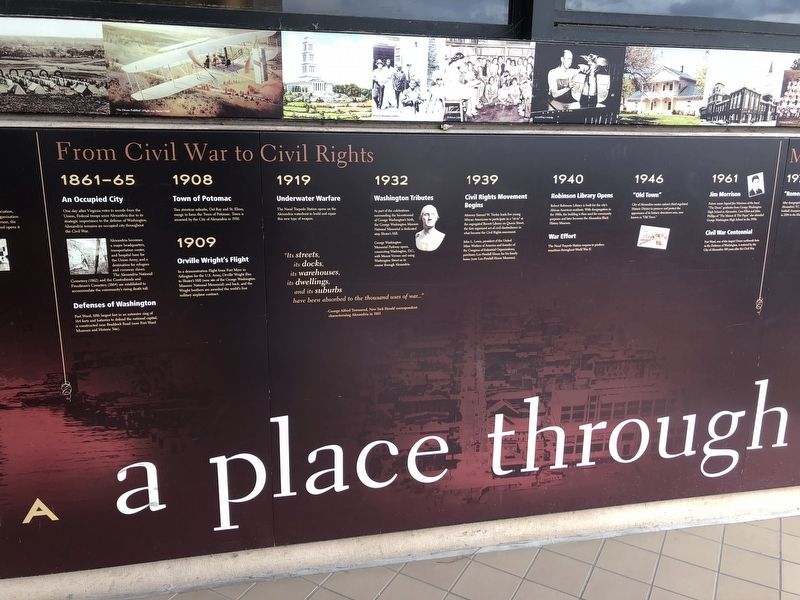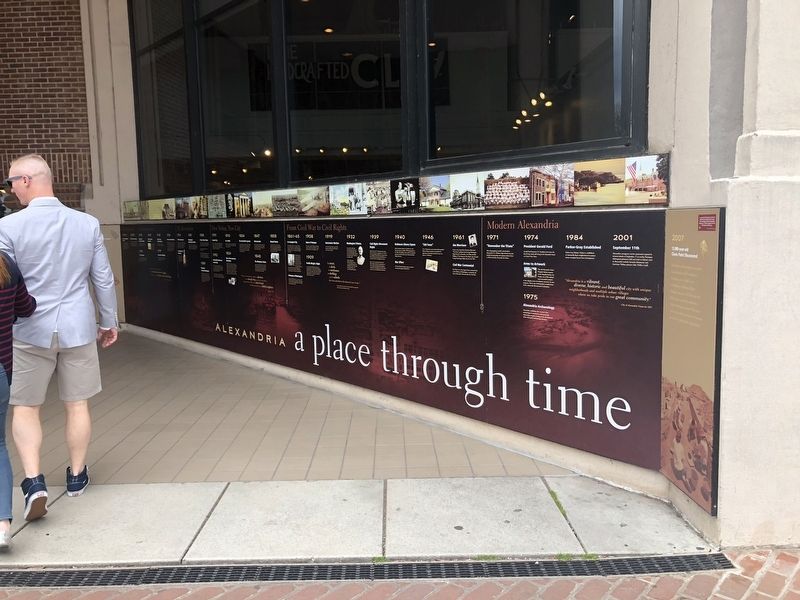Old Town in Alexandria, Virginia — The American South (Mid-Atlantic)
Alexandria
A Place Through Time
13,000 years ago
The Paleoindian Period
A Native American hunter during the Paleoindian period discards a broken spear point, on a bluff overlooking a tributary to the Potomac River at the southern edge of present-day Alexandria.
The Beginning
4,000 years ago
Quartz and Quartzite Cobbles
People carry quartz and quartzite cobbles from a small tributary stream of the Potomac to a bluff top near the current intersection of Interstate 395 and Braddock Road. They chip off pieces of the cobbles to make stone spear points for use in hunting deer and small game and in fishing for shad and other spawning fish.
1,000 years ago
Native American Camp
Native Americans establish a small seasonal campsite at present-day Jones Point to hunt and exploit the resources of the adjacent marshland. They live in circular structures about 12 feet in diameter made of bent saplings, probably covered with bark or mats.
Colonial America
1608
Exploration of the Chesapeake
Captain John Smith's shallop sails past what is now Alexandria in his quest for precious minerals and a Northwest Passage.
1654
First Land Grant
Margaret Brent, first female lawyer in American and advisor to the governor of Maryland, receives a grant of land from the Virginia governor that includes the future site of Alexandria.
1669
John Alexander Buys Land
Scottish merchant John Alexander purchases some of the former Brent land from a Welsh ship captain for "six thousand pounds of Tobacco and Cask."
1748
A New Town on the Potomac
George Washington, a teenage surveyor, draws plan of a new town called Alexandria.
1749
Alexandria Established
Virginia's colonial government grants permission to a group of merchants and planters to establish a town called Alexandria.
1755
French and Indian War
British General Edward Braddock arrives with several thousand Redcoats to quell the encroaching French and their Indian allies. He establishes his headquarters at the home of John Carlyle (present-day Carlyle House Historic Park). Braddock's arrogance and mortal defeat at the battle of Monongahela (near present-day Pittsburgh) are harbingers of Britain's decline.
"Alexandria is beyond all comparison
the handsomest town in Virginia
and indeed is among the finest in the United States."
-The Duc de la Rochefoucauld, 1796
The Revolution
1774
"Fairfax Resolves"
Upset over British taxation,
Friendship Fire Company
Alexandria's first volunteer fire company founded; in 1855 new firehouse is constructed (now Friendship Firehouse Museum).
1781
Washington-Rochambeau Route
American and French armies move southward to besiege British forces. Allied supply-wagon train forms a half-mile-wide camp at Alexandria, before moving on to Yorktown to end the Revolutionary War.
1785
A Town Takes Shape
John Wise, local tavernkeeper and entrepreneur, constructs a tavern (now Gadsby's Tavern Museum) with the largest function room in Alexandria.
The Alexandria Academy, the town's first public school, opens.
Philip Richard Fendall builds house on Oronoco Street on lot purchased from his cousin, Revolutionary War hero Henry "Light Horse Harry" Lee (now Lee-Fendall House Museum).
1789
President George Washington
George Washington becomes first president of the United States of America and leaves Alexandria for New York. Before his presidency, he maintained a town house on Cameron Street, had a family pew at Christ Church, and dined, danced and conducted
New Nation, New City
1791
Federal City
First and southernmost cornerstone for new Federal capital is set at Alexandria's Jones Point with help of African-American surveyor and mathematician Benjamin Banneker; the town officially becomes part of the District of Columbia in 1801.
1792
Successful Commerce on the Rise
Edward Stabler opens an apothecary, one of several successful commercial ventures by Quakers in Alexandria, that is operated by his descendants in the Leadbeater family until 1933 (now Stabler-Leadbeater Apothecary Museum).
The new City Tavern opens on Royal Street and becomes famous when managed by John Gadsby four years later (today known as Gadsby's Tavern Museum).
1810
Lee Family
Revolutionary War hero Henry "Light Horse Harry" Lee moves to Alexandria with his family including young son Robert E. Lee.
1824
Hero of the American Revolution
The Marquis de Lafayette, hero of the American Revolution, visits Alexandria for a Grand Reception and Celebration held in his honor and, while here, calls on the widow of his old comrade Henry Lee. Lafayette, the last surviving general of the Revolutionary War, was invited by President James Monroe to be "The Nation's Guest," attending
1834
The Alexandria Lyceum
A group of gentlemen interested in public education and scientific inquiry organize themselves as the Alexandria Lyceum. Five years later, they build their own hall (now known as The Lyceum, Alexandria's History Museum), sharing it with the Alexandria Library.
1847
Retrocession
With limited federal financial assistance and voting rights, Alexandrians vote to retrocede from the District of Columbia back to the Commonwealth of Virginia.
1848
The Edmonson Sisters
Sisters Emily and Mary Edmonson are held at an Alexandria slave jail after an escape attempt on schooner The Pearl. The girls' case captures the attention of abolitionist Harriet Beecher Stowe, and they ultimately gain their freedom.
1858
Mount Vernon
The Mount Vernon Ladies' Association, the first national preservation organization in America, acquires Mount Vernon, the home of George Washington, and it opens to the public two years later.
"There is no community to which my affections
more strongly cling than that of Alexandria,
composed of my earliest and oldest friends,
my kind school fellows and faithful neighbors."
-Robert E. Lee, 1870
From
1861-65
An Occupied City
One day after Virginia votes to secede from the Union, Federal troops seize Alexandria due to its strategic importance to the defense of Washington. Alexandria remains an occupied city throughout the Civil War.
Alexandria becomes a major headquarters, transportation center and hospital base for the Union Army, and a destination for refugees and runaway slaves. The Alexandria National Cemetery (1862) and the Contrabands and Freedman's Cemetery (1864) are established to accommodate the community's rising death toll.
Defenses of Washington
Fort Ward, fifth largest fort in an extensive ring of 164 forts and batteries to defend the national capital, is constructed near Braddock Road (now Fort Ward Museum and Historic Site).
1908
Town of Potomac
Two streetcar suburbs, Del Ray and St. Elmo, merge to form the Town of Potomac. Town is annexed by the City of Alexandria in 1930.
1909
Orville Wright's Flight
In a demonstration flight from Fort Myer in Arlington for the U.S. Army, Orville Wright flies to Shuter's Hill (now site of the George Washington Masonic National Memorial) and back, and the Wright brothers are awarded the first military airplane contract.
1919
Underwater
The Naval Torpedo Station opens on the Alexandria waterfront to build and repair this new type of weapon.
1932
Washington Tributes
As part of the celebrations surrounding the bicentennial of George Washington's birth, the George Washington Masonic National Memorial is dedicated atop Shuter's Hill.
George Washington Memorial Parkway opens, connecting Washington, D.C., with Mount Vernon and using Washington Street as its course through Alexandria.
1939
Civil Rights Movement Begins
Attorney Samuel W. Tucker leads five young African Americans to participate in a "sit in" at the segregated Barrett Library on Queen Street, the first organized act of civil disobedience in what became the Civil Rights movement.
John L. Lewis president of the United Mine Workers of America and founder of the Congress of Industrial Organizations, purchases Lee-Fendall House for his family home (now Lee-Fendall House Museum).
1940
Robinson Library Opens
Robert Robinson Library is built for the city's African American residents. With desegregation in the 1960s, the building is then used for community purposes and later becomes the Alexandria Black History Museum.
War Effort
The Naval Torpedo Station reopens to produce munitions throughout
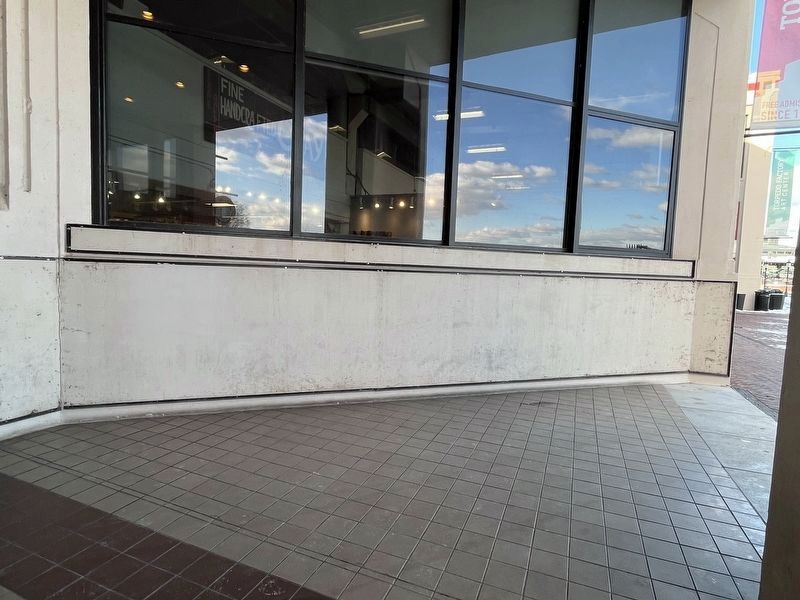
Photographed By Devry Becker Jones (CC0), January 20, 2024
7. Alexandria Marker
The marker has gone missing.
1946
"Old Town"
City of Alexandria creates nation's third regulated Historic District to preserve and protect the appearance of its historic downtown area, now known as "Old Town."
1961
Jim Morrison
Future music legend Jim Morrison of the band "The Doors" graduates from George Washington High School in Alexandria. Cass Elliot and John Phillips of "The Mamas & The Papas" also attended George Washington High School in the 1950s.
Civil War Centennial
Fort Ward, one of the largest Union earthwork forts in the Defenses of Washington, is restored by the City of Alexandria 100 years after the Civil War.
"Its streets,
its docks,
its warehouses,
its dwellings,
and its suburbs
have been absorbed to the thousand uses of war..."
-George Alfred Townsend, New York Herald correspondent characterizing Alexandria in 1863
Modern Alexandria
1971
"Remember the Titans"
After desegregating its public school system, Alexandria's T.C. Williams High School wins state football championship and captures fame in 2000 in the film, Remember the Titans.
1974
President Gerald Ford
Gerald Ford becomes U.S. President and serves his first 10 days while still living in his Alexandria home on Crown View Drive.
Arms to Artwork
The old Alexandria Naval Torpedo Station reopens as the Torpedo Factory Art Center, one of the nation's most successful projects in the adaptive reuse of a historic structure for arts purposes. This is one of Alexandria's contribution to the nationwide Bicentennial Celebration.
1975
Alexandria Archaeology
Alexandria establishes the country's first archaeological commission and community archaeology program, leading to the development of the Alexandria Archaeology Museum.
1984
Parker-Gray Established
Parker-Gray Historic District is established in historically black neighborhood to protect owner-occupied homes from development.
2001
September 11th
Alexandria emergency service personnel respond to terrorist attacks of September 11 at nearby Pentagon. Subsequent prisoners held and tried in federal court in Alexandria include Zacarias Moussaoui and American Taliban prisoner John Walker Lindh.
"Alexandria is a vibrant,
diverse, historic and beautiful city with unique
neighborhoods and multiple urban villages
where we take pride in our great community."
-City of Alexandria Vision for 2015
2007
13,000-year-old Clovis Point Discovered
Alexandria's archaeologists excavating Contrabands and Freedmen's Cemetery, on a bluff once overlooking a Potomac River tributary, recover a 13,000-year-old Clovis spear point discarded by a Native American Hunter. The stone tool is the earliest evidence of human presence in present-day Alexandria.
To view the Clovis point and more artifacts from Alexandria's past, visit the Alexandria Archaeology Museum, 3rd floor Torpedo Factory Arts Center, Studio 327. www.AlexandriaArchaeology.org
Erected by City of Alexandria.
Topics and series. This historical marker is listed in these topic lists: Colonial Era • Native Americans • War, US Civil • War, US Revolutionary. In addition, it is included in the Former U.S. Presidents: #01 George Washington, the Former U.S. Presidents: #05 James Monroe, the Former U.S. Presidents: #38 Gerald R. Ford, Jr., the Lafayette’s Farewell Tour, and the Virginia, The City of Alexandria series lists.
Location. Marker has been reported missing. It was located near 38° 48.275′ N, 77° 2.385′ W. Marker was in Alexandria, Virginia. It was in Old Town. Marker could be reached from North Union Street east of Fayette Alley, on the right when traveling north. Touch for map. Marker was at or near this postal address: 105 North Union Street, Alexandria VA 22314, United States of America. Touch for directions.
Other nearby markers. At least 8 other markers are within walking distance of this location. Plundered! (here, next to this marker); United States Naval Torpedo Station (Building Two) (within shouting distance of this marker); Torpedo Factory Art Center (within shouting distance of this marker); Alexandria Archaeology Museum (within shouting distance of this marker); River Ferries (within shouting distance of this marker); a different marker also named Torpedo Factory Art Center (within shouting distance of this marker); John Fitzgerald (within shouting distance of this marker); Waterfront Walk (within shouting distance of this marker). Touch for a list and map of all markers in Alexandria.
Also see . . . Alexandria Archaeology Museum. (Submitted on April 2, 2018.)
Credits. This page was last revised on January 20, 2024. It was originally submitted on April 1, 2018, by Devry Becker Jones of Washington, District of Columbia. This page has been viewed 587 times since then and 44 times this year. Last updated on February 7, 2021, by Carl Gordon Moore Jr. of North East, Maryland. Photos: 1, 2, 3, 4, 5, 6. submitted on April 1, 2018, by Devry Becker Jones of Washington, District of Columbia. 7. submitted on January 20, 2024, by Devry Becker Jones of Washington, District of Columbia.
